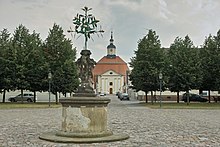Oranienbaum town church
The town church Oranienbaum in the town of Oranienbaum-Wörlitz in the district of Wittenberg in Saxony-Anhalt is under monument protection and is registered in the monument register with the registration number 094 40415 as a monument . Today the church belongs to the Oranienbaum parish in the Dessau parish of the Evangelical Church of Anhalt .
Location and history
Oranienbaum's town church was built between 1704 and 1712 as a reformed church . The founder was Prince Leopold I of Anhalt-Dessau . While the castle formed the end of the eastern city axis from the market, the city church took on this function in the southern axis, but also represents the first southern city expansion, as it no longer belongs to the originally planned baroque layout of the city. In the direct line of sight of the castle, the Prussian border made construction impossible. The church is therefore at the same distance from the market and the castle. A few decades later, the small church was another sacred central building in Oranienbaum.
The church is - after the Trinity Church in Zerbst - the earliest example of a baroque central building in Anhalt. A house of worship was built on an elliptical floor plan with a high hipped mansard roof . On top of this sits an eight-sided roof tower with a Welscher hood . Risalites are located in front of the east, north and west façades , with the main entrance on the north side being highlighted by four monumental pilasters . Variety in the plastered facade is created not only by differently designed window openings, but also by a strip of cornice below the eaves .
Interior and outfit
Noteworthy is the flat dome and the also elliptical gallery, which, however, was changed for the installation of the organ. This organ is a donation from Prince Leopold III. which a member of the Zuberbier family of organ builders and the carpenter Christian Nicolaus created in 1766 and 1767. It was rebuilt in 1860 and 1906. The prince's chair, altar and pulpit , however, date from the construction period . The bell made in 1714 by Georg Andreas Dauber (Leipzig) has also been preserved. Two more bells were melted down during World War I and replaced in 1919. A baptismal font and several worship implements from 1676 come from the previous building. The heating was modernized several times (1886, 1934). An intermediate gallery from 1738 was removed during the renovation in 1905/1906. Due to sponge infestation, another renovation was necessary in 1910. Another renovation took place in 1994.
predecessor
The previous building was consecrated on October 17, 1676. This church was a foundation of Leopold I's mother Henriette Catharina von Oranien-Nassau , who had named Nischwitz three years earlier (1673) and had the Oranienbaum Castle built as a summer residence. However, after a short time this church became too small for the needs of the town, which was growing rapidly thanks to Henriette's support, and was therefore demolished in 1707. It is not known whether the village of Nischwitz also had a church, as the place was parish after Wörlitz.
literature
- Georg Dehio : Handbook of the German art monuments . Saxony Anhalt II. Administrative districts Dessau and Halle. Deutscher Kunstverlag, Munich / Berlin 1999, ISBN 3-422-03065-4 .
- Ernst Haetge, Marie-Luise Harksen: Dessau-Köthen district. First part: The city of Köthen and the district except Wörlitz (= The art monuments of the State of Anhalt ; 2.1), August Hopfer Verlag, Burg 1943.
- Heinrich Lindner: History and description of the state of Anhalt . Chr. G. Ackermann, Dessau 1833 ( digital copy [accessed on July 26, 2020] Reprint: Flyhead Verlag, Halle 1991).
Web links
- Evangelical Church Community Oranienbaum (with contact details), accessed on November 7, 2019.
- Information about the organ. In: orgbase.nl. Retrieved July 26, 2020 (German, Dutch).
Individual evidence
- ↑ List of monuments of the state of Saxony-Anhalt (pdf, 9.9 MB) - answer of the state government to a small question for written answer (the delegates Olaf Meister and Prof. Dr. Claudia Dalbert; Bündnis 90 / Die Grünen) - printed matter 6/3905 from March 19, 2015 (KA 6/8670)
- ↑ Church district Dessau , accessed on November 7, 2019.
- ↑ Haetge / Harksen, pp. 250-251. The foundation stone was laid in 1704. Since the previous building was demolished in 1707, the town church must have already developed so far that it could be used. The indication of the laying of the foundation stone in 1707 is therefore probably a misunderstanding.
- ^ Oranienbaum , accessed November 7, 2019.
- ↑ Haetge / Harksen, p. 251.
- ^ Dehio, p. 638.
- ↑ Haetge / Harksen, pp. 251-254.
- ^ Dehio, p. 639.
- ^ Community website , accessed November 7, 2019.
- ↑ Lindner, Vol. 2, pp. 270-271.
- ↑ Haetge / Harksen, p. 250.
Coordinates: 51 ° 47 ′ 50.5 " N , 12 ° 24 ′ 23.8" E

